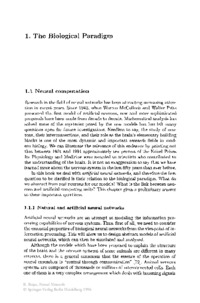The Biological Paradigm |
 |
 Diese Seite wurde seit 6 Jahren inhaltlich nicht mehr aktualisiert.
Unter Umständen ist sie nicht mehr aktuell.
Diese Seite wurde seit 6 Jahren inhaltlich nicht mehr aktualisiert.
Unter Umständen ist sie nicht mehr aktuell.
 Zusammenfassungen
Zusammenfassungen

Research in the field of neural networks has been attracting increasing attention in recent years. Since 1943, when Warren McCulloch and Walter Pitts presented the first model of artificial neurons, new and more sophisticated proposals have been made from decade to decade. Mathematical analysis has solved some of the mysteries posed by the new models but has left many questions open for future investigations. Needless to say, the study of neurons, their interconnections, and their role as the brain´s elementary building blocks is one of the most dynamic and important research fields in modern biology. We can illustrate the relevance of this endeavor by pointing out that between 1901 and 1991 approximately ten percent of the Nobel Prizes for Physiology and Medicine were awarded to scientists who contributed to the understanding of the brain. It is not an exaggeration to say that we have learned more about the nervous system in the last fifty years than ever before.
 Dieses Kapitel erwähnt ...
Dieses Kapitel erwähnt ...
 Personen KB IB clear | Alonzo Church , David Hilbert , Warren McCulloch , John von Neumann , Walter Pitts , Alan Turing , Konrad Zuse | ||||||||||||||||||
 Begriffe KB IB clear | Automatautomat
, BerechenbarkeitComputability
,  Biologie Biologie biology
, Church-Turing-These
, biology
, Church-Turing-These
,  Gehirn Gehirn brain
, Informationsverarbeitunginformation processing
, brain
, Informationsverarbeitunginformation processing
,  Kommunikation Kommunikation communication
, Lambda-Kalkül
, communication
, Lambda-Kalkül
,  Lernen Lernen learning
, Naturnature
, learning
, Naturnature
,  Nervensystem Nervensystem nervous system
, nervous system
,  Neuron Neuron neuron
, Paradigmaparadigm
, Rekursionrecursion
, Turing-Maschineturing machine
, neuron
, Paradigmaparadigm
, Rekursionrecursion
, Turing-Maschineturing machine
,  Zelle Zelle cell
, Zelluläre AutomatenSelf-Reproducing Automata cell
, Zelluläre AutomatenSelf-Reproducing Automata
| ||||||||||||||||||
 Bücher |
| ||||||||||||||||||
 Texte |
|
 Dieses Kapitel erwähnt vermutlich nicht ...
Dieses Kapitel erwähnt vermutlich nicht ... 
 Nicht erwähnte Begriffe | Neurobiologie, Zellmembran |
 Tagcloud
Tagcloud
 Zitationsgraph
Zitationsgraph
 Zitationsgraph (Beta-Test mit vis.js)
Zitationsgraph (Beta-Test mit vis.js)
 Anderswo finden
Anderswo finden
 Volltext dieses Dokuments
Volltext dieses Dokuments
 |  The Biological Paradigm: Artikel als Volltext bei Springerlink ( The Biological Paradigm: Artikel als Volltext bei Springerlink ( : :  , 2854 kByte; , 2854 kByte;  : :  ) ) |
 Anderswo suchen
Anderswo suchen 
 Beat und dieses Kapitel
Beat und dieses Kapitel
Beat hat Dieses Kapitel während seiner Zeit am Institut für Medien und Schule (IMS) ins Biblionetz aufgenommen. Beat besitzt kein physisches, aber ein digitales Exemplar. Eine digitale Version ist auf dem Internet verfügbar (s.o.). Es gibt bisher nur wenige Objekte im Biblionetz, die dieses Werk zitieren.









 Biblionetz-History
Biblionetz-History